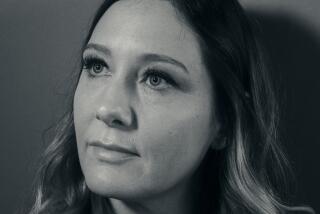A ‘WORKING GIRLS’ ’ BOSWELL
NEW YORK — It’s not every week that an independently produced, intelligently conceived low-budget movie turns out to be one of the top-grossing films in New York on its opening weekend. And it’s especially rare when the writer-director-producer-editor is a woman. Consequently, “Working Girls” is becoming something of a phenomenon--a provocative but hardly erotic story of upscale prostitutes in the Big Apple.
Then again, Lizzie Borden (who changed her name from Linda Borden to Lizzie because that’s what everyone called her) is not your typical film maker. To make “Working Girls” (currently at the Westside Pavilion and Beverly Center Cineplex in Los Angeles and the Rialto in South Pasadena) with the freedom she needed, the vivacious young director turned her own downtown Manhattan home into the set, and shot her film there. “I built a set in my loft--a brothel with moving walls,” she recalled.
A Wellesley-educated painter and art critic, Borden moved into directing from film editing. Her first movie was “Born in Flames,” a controversial feminist drama. She then became interested in what she called “a whole new breed of yuppie madams who have come from the fashion industry and Wall Street,” and some college-educated women who work in these small brothels.
“The more I saw, the more I realized it didn’t fit the stereotypes I’d seen in movies, where the element of degradation or victimization tends to dominate,” said the Detroit-born director. What she found missing in films was “the sense of humor which enables the women to handle prostitution,” as well as the daily realities of the job.
Borden explained that the project took shape when she began meeting women from the art world. “They were well educated--from Yale, Columbia, Sarah Lawrence--and worked as prostitutes. I had to transform my own ideas: For example, street prostitution is different from the middle-class prostitution I began to encounter.
The petite director, who is in her mid-30s, visited a number of these “houses,” and learned the different rituals--”how it worked, what kind of safety measures there were for women in terms of health, police protection and dangerous clients,” she said.
Borden also realized that prostitution “is not about sex for the women. Even the sexual movements are codified, or entirely theatrical for them. Many of these women work for specific reasons--to put themselves through college, because they don’t have a green card, to place their kid in a private school. . . . They work for a short period, then stop and nobody knows about it.”
Opting for a non-judgmental--and non-titillating--look at one day in the life of five young, middle-class “working girls,” Borden decided to make a movie “which focused on these daily rituals,” in her own words, “but shot in a cold way.”
In her review of the film, Times critic Sheila Benson observed that “what we see in the course of (a very long day) is funny, insightful, banal, sad, tedious, informational, infuriating--everything but erotic. There is a businesslike nudity, upstairs in the bedrooms between the women and their clients, and one after another ‘sexual situation,’ but it would be difficult to find anything remotely sexy in these exchanges.” (Although the film is unrated, its ad states that because of its explicit nature, no one younger than 18 will be admitted.)
“If you remove the moral judgment,” Borden said, “it’s de-romanticized. The romance of prostitution has to do with the ‘bad girl’--either on the lowest level, the street, or the highest call-girl-with-furs level--her impending disaster and chastening. What fascinated me was the ritual part--the hygiene of this hotel-like atmosphere--and the camaraderie among the women.”
Although the film maker wanted to capture some of the boredom the women experience in these small brothels, “Working Girls” is far from boring. Its success on the film festival circuit--including the U.S. Film Festival in Utah, where it won a prize--can be attributed partly to the film’s wacky humor. And its angle on women who provide what men have called “horizontal refreshment” is quite original.
The focus is Molly (Louise Smith), an intelligent and sensitive young woman who works in a Manhattan apartment run by a brassy madam (Ellen McElduff) who seems to mother both the girls and the clients.
Borden admitted that the casting was difficult, especially for the male roles. Whereas the female leads were played primarily by off-Broadway stage actresses, most of the men are not professional actors. Referring to a Chinese client in “Working Girls,” Borden confessed that she located him through Screw magazine “because I couldn’t find a Chinese man over 35 who would take his clothes off! It was crazy. In some ways, I was treating the men in the film the way a man would pay a prostitute: The more clothes they took off, the more money I gave them,” she said with a laugh.
When the actresses first came to rehearsals, they dressed according to their preconception of a prostitute. “They looked like street hookers,” Borden remarked, “so I made all of them go to a real ‘house’ and apply for a job. They came back amazed: They said that the women there reminded them of their college roommates. It changed their conception of how to play these parts.”
Many viewers, including women, have criticized Borden’s non-judgmental depiction of what many still consider to be a humiliating and exploitative profession. Her response is to term the film “feminist because it shows prostitution from a woman’s point of view.
“As long as prostitution exists, women have to take control of it, and of the images,” she insisted. “We all wish prostitution didn’t exist. But as long as there is such an economic differential in this culture between what men and women earn . . . a woman has the right to choose. If she decides to rent her body rather than work a demeaning 40-hour week, she should not automatically be seen as a ‘fallen woman.’ ”
Borden’s six months of research led her to realize that prostitution is less an isolated exploitation than a mirror of situations in other parts of our culture: “There’s an even exchange between the man with the money and the woman with the commodity to rent.
“Prostitution is perhaps the lowest form of selling yourself in this culture; but within capitalism, one is always selling an aspect of oneself. In advertising, for example, people sell their skills to service a commodity. Who can decide whether renting your body is worse than renting your brain?”
Borden likens the working girls to other “service jobs that women have--like waitress, hostess, secretary--where they have to meet men and make them feel comfortable. The interactions I observed reminded me of situations in worlds other than prostitution.”
Her next project is a far cry from the de-eroticized rituals of “Working Girls.” She is hoping to direct a comedy with Jerry Stiller and Anne Meara, from a script by Isaiah Sheffer. “It’s in the Tracy-Hepburn mode,” she said, “about people who work together and still have a passionate relationship with each other after they’re 50.”
More to Read
Only good movies
Get the Indie Focus newsletter, Mark Olsen's weekly guide to the world of cinema.
You may occasionally receive promotional content from the Los Angeles Times.










